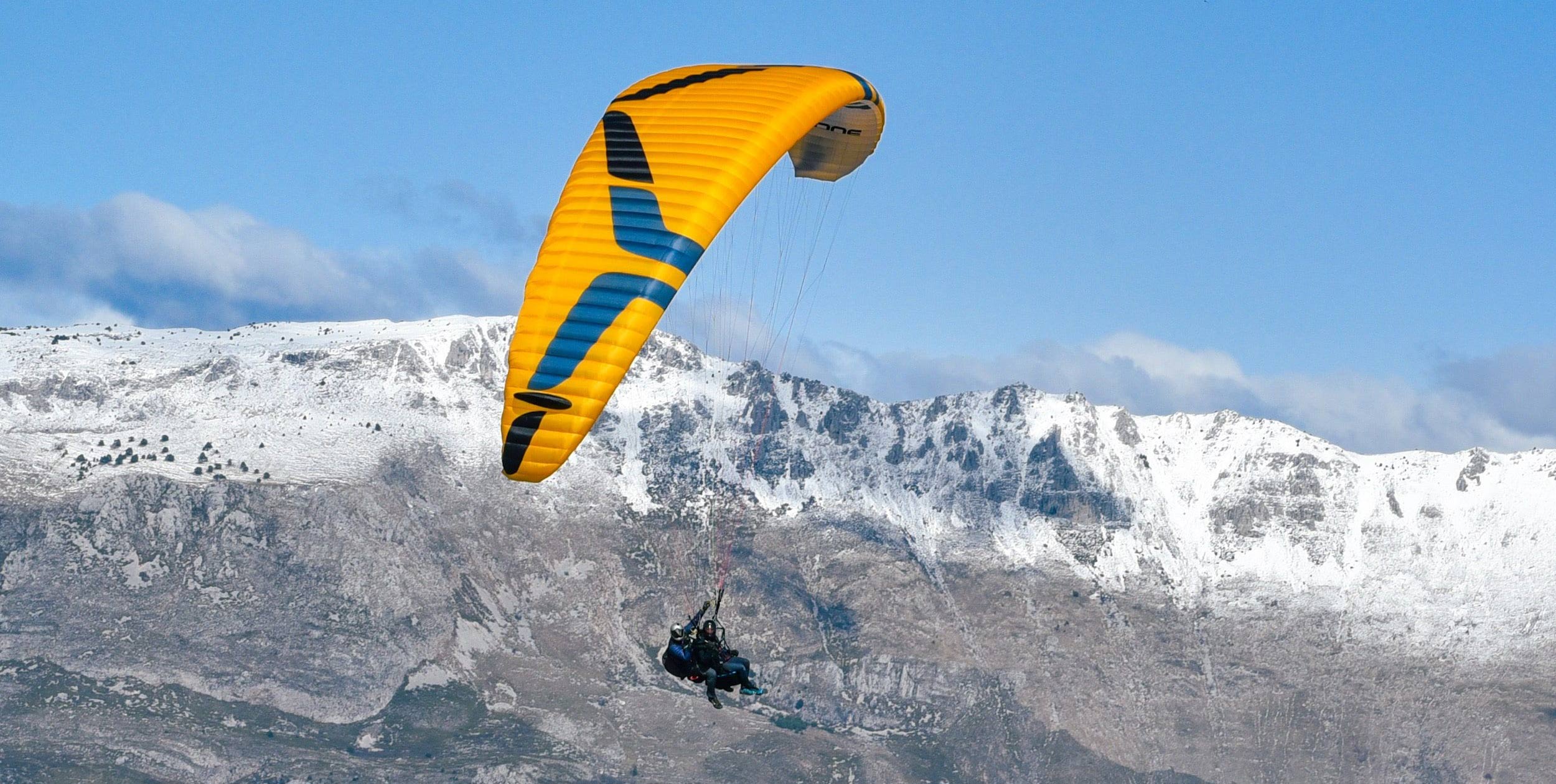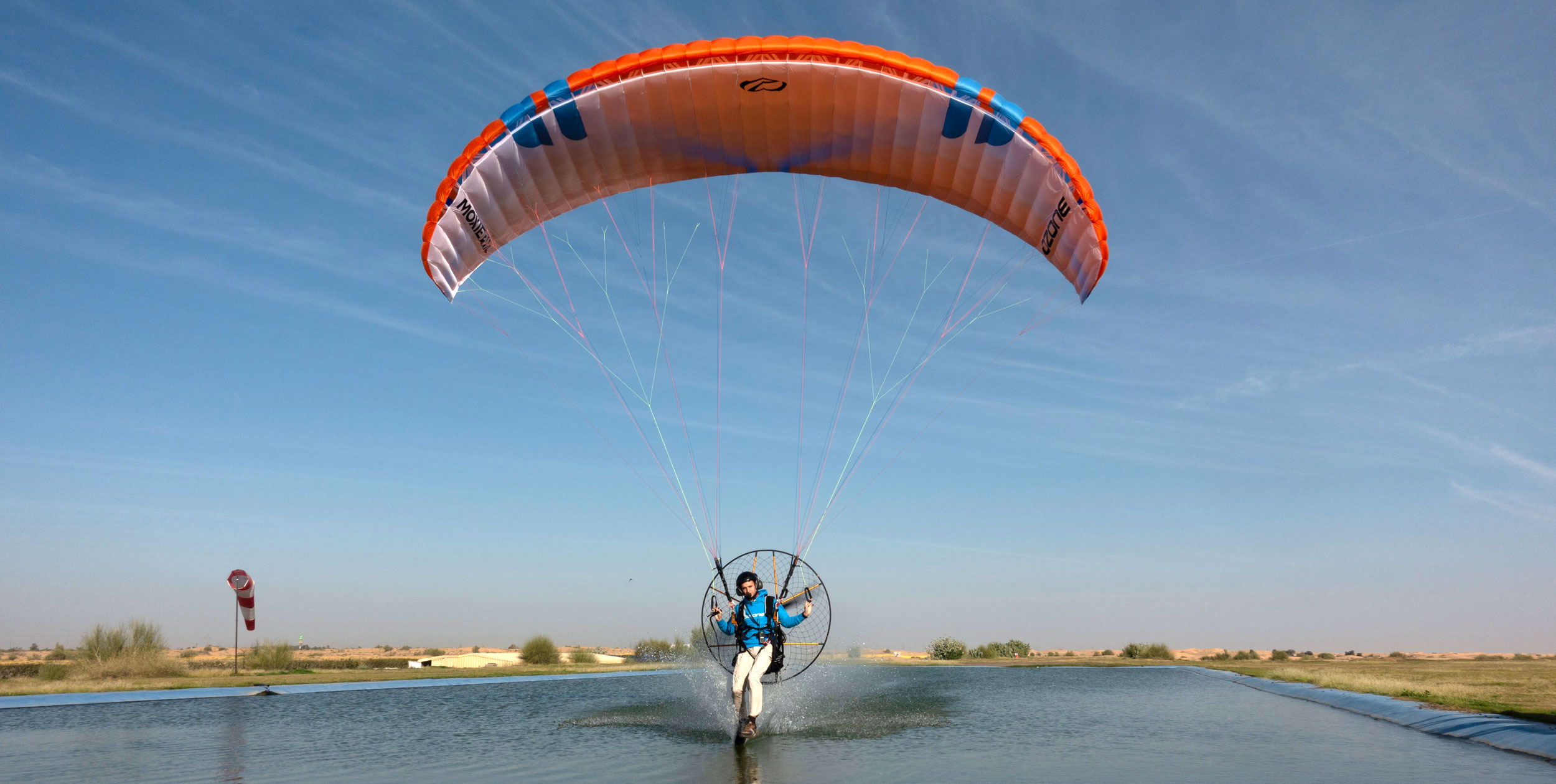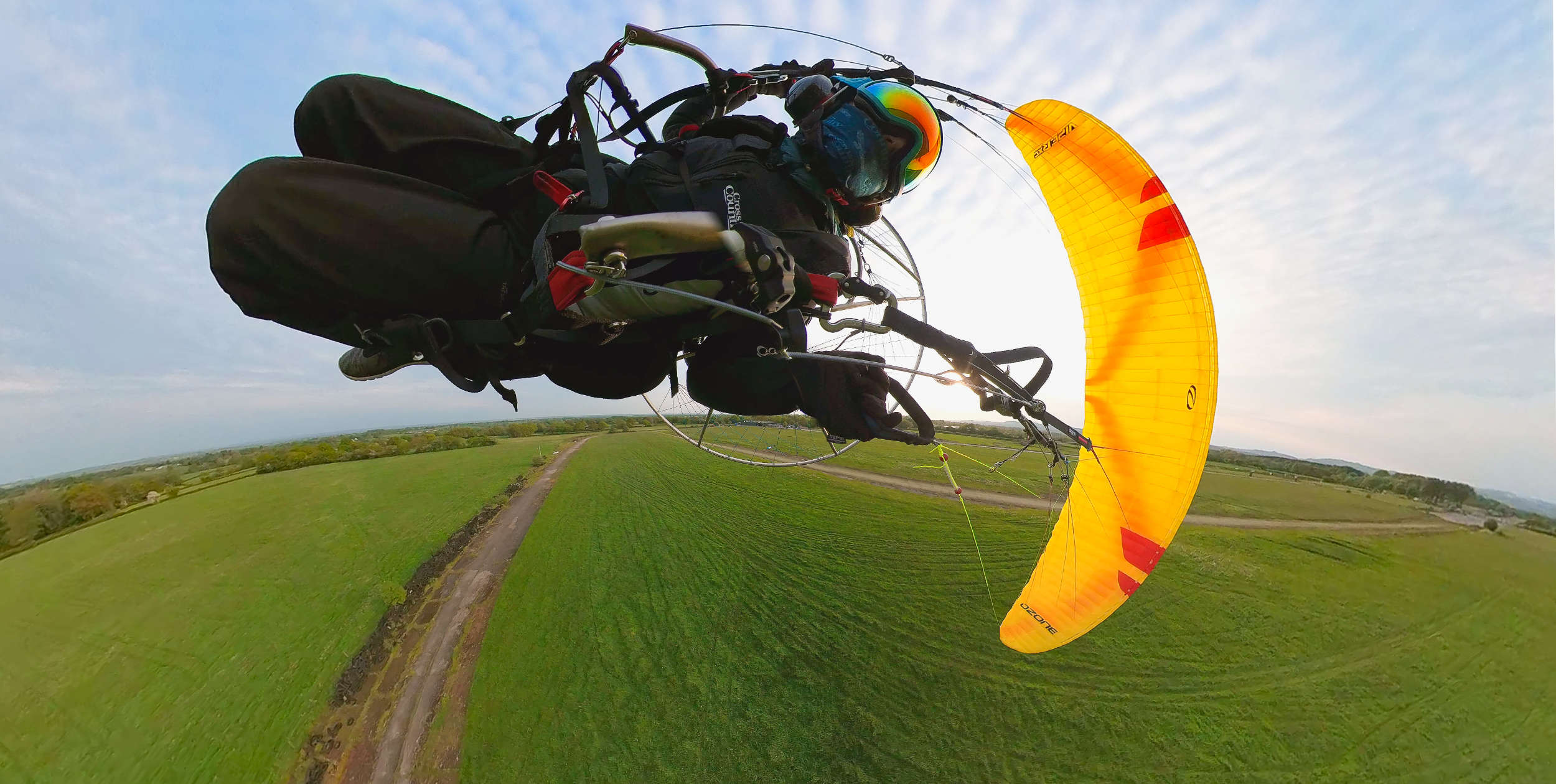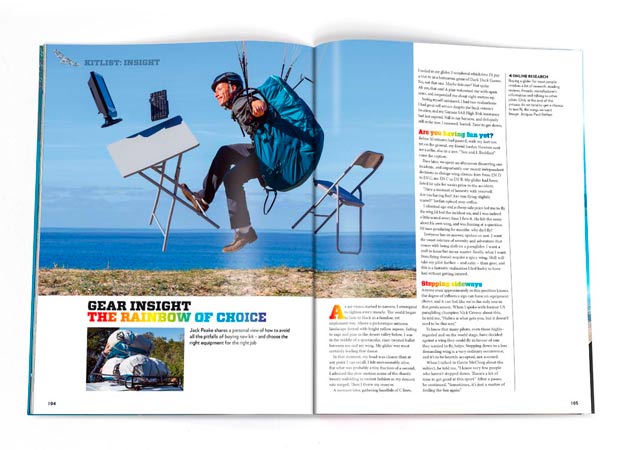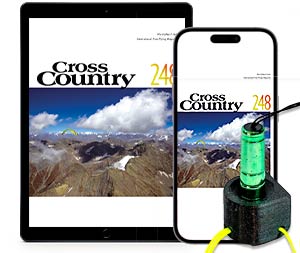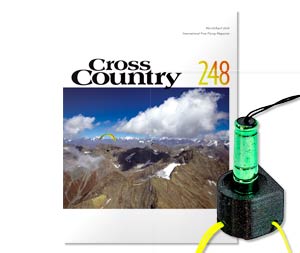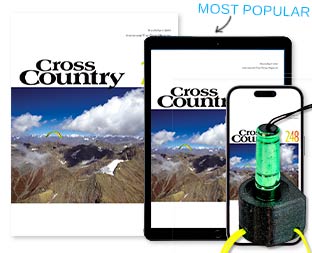WAVES OF HEAT wafted up at me from Roldanillo as I made a lazy spiral down to the landing field. Straightening up, the Zeno rocketed back behind me and climbed vigorously back up into the sky, and for the first time ever I found myself questioning how much further paragliding development could actually go. Here was a wing I’d spent three hours flying around the Cauca Valley, corkscrewing up punchy climbs in the hills, then taking full-bar glides next to Mark Watts on his Enzo 2 and not losing out a metre in height against him. Yet coming into the landing field, the energy of this wing became so much more obvious.
No doubt about it, the Zeno’s got more than a few volts of electricity about it. I was lucky enough to fly an MS Zeno for 30 hours in Colombia in January, flying alongside pilots racing in the Colombian Open. I then took it to the French Alps for a couple of days of winter flying at Gourdon before doing some full stall practice with it over Monaco. I also got to fly Seb Ospina’s ML to compare it with. My background is in flying XC, and for the past three years I’ve flown Triple Seven’s King (EN D) for 70 hours, my R12 (Open class) for 40 hours or so, the GTO2 (EN D/C) for 25 hours, the M6 (EN D) for 80 hours and other EN C wings for shorter periods. Here’s what I think I can confidently say about the Zeno so far.

Women’s Paragliding World Champion Seiko Fukuoka Naville (red) and 2011 Paragliding World Champion Charles Cazaux at home in the French Alps. Photo: Jorge Atramiz
The Feel
Whether in tight punchy cores or racing at half- to full-bar, the Zeno is a direct and energetic wing that needs proper piloting. It is a two-liner to the core, and needs a different piloting style to three-liners. On glide, I needed to learn to trust in my rear-riser control, which took time. When thermalling, it’s like someone’s taken the suspension off your car in preparation for a track day: you need more pitch and roll control to steer it through the air’s lumps, bumps and edges. I flew the King throughout 2016, and it was such a lovely, comfortable wing, needing little more management than many of the safest EN-Cs. It’s a cruisy feeling wing with absolutely shedloads of performance hidden away under its bonnet. The Zeno is more flash. It wears its performance on its sleeve. It’s your athletic friend, knocking on your door at 7am encouraging you to get out in the drizzle and try and knock 10 seconds off your 5km race time. It’s more demanding, and doesn’t pretend to be otherwise.
‘Top performance, acceptable behaviour’
If seconds count, this is your wing. In testing against the Enzo 2, Ozone’s Luc Armant reported a 0.4 advantage on glide at full speed for the Zeno, and several pilots’ experience at the Superfinal and Colombian Opens back this up. For absolute top performance pilots right now will be looking at the GIN Boomerang 11, which Ozone admit has a speed advantage over their current offerings. But the Zeno isn’t really aimed at the elite-of-the-elite. Its ‘World Cup performance for everyone’ appeal is pulling at the heartstrings of many retired competition pilots. At Gourdon, I bumped into brothers Nicolas and Pascal Bernadin, both former top-level competitors; Nicolas used to win PWCs and was a regular on the French team. Both were on take-off with their old Impress 2 harnesses and new Zenos. As Nicolas put it, the allure of a top-performance machine with what he calls ‘acceptable behaviour’ is too much to resist.
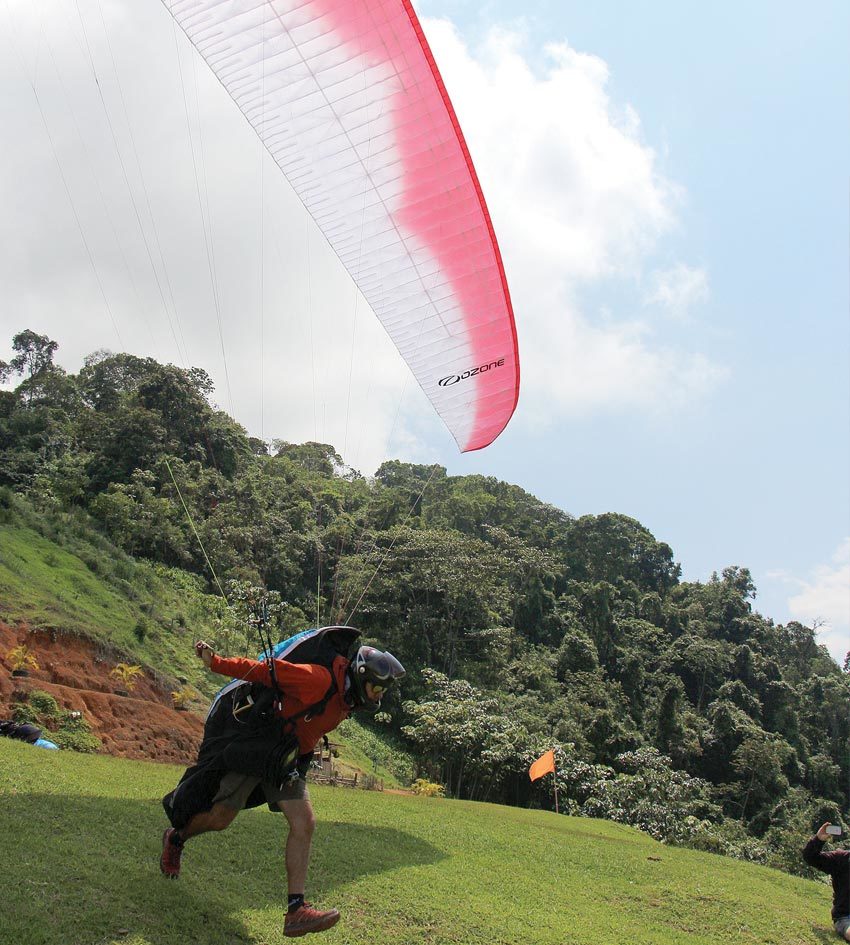
On launch in Colombia. Fly the Zeno at the top of the weight range, or around 3kg below if you’re flying in light conditions. Photo: Hugh Miller
Thermalling
But what does ‘acceptable’ mean? Most Enzo 2 pilots report that the wing feels like a pussycat – but I beg to differ. My experience in Colombia is that in lively conditions, the Zeno is around 30% to 40% more demanding to fly than the King or M6. It just takes a lot more work, a lot more reining in when you hit a strong core.
With its comparatively flat arc, it isn’t as easy to dig a tip into the core and swing it around. It has a less coordinated feel in climbs – it feels like it reacts more to the air around it, perhaps because it has more energy, so you just need to be more on it. Compared to an R12 – and I assume most other Open or CCC wings – the Zeno isn’t as sniffy. It doesn’t tell you as much about what’s going on, and won’t lead you into the core in quite the same wonderful way as an even higher aspect ratio wing. But I’m being picky, here.
On glide
On glide, the wing’s leading edge feels like it solidifies. I can’t tell you what a pleasure it is to finally be able to experience the delights of CCC performance in a much more compact, comfortable package. Of course, there’s far more feedback through the rear risers than you’ll ever get on a three-liner, and a lot more than the Icepeak series, too. Experienced two-line pilots rightly point out that, when flown properly, the Zeno is safer to fly at speed than most three-liners because of the warning the wing will give you of any imminent collapses through the rear riser pressure. Using our Oxford University wind-tunnel calibrated TAS speed probe I measured a top speed of 57km/h on the Zeno MS at 97kg, but you could take this up or down 1-2 km/h depending on wing loading and size. Trim speed was measured at 36km/h.

Ozone SharkNose technology. The glider has 78 cells and a flat aspect ratio of 6.9. Photo: Hugh Miller
Wing loading
The MS’s weight range is 85-100kg. I flew it at 93, 97, 99 and 104 kg, with both the Forza and Exoceat harnesses. I didn’t really want to fly it at 104kg, but Ozone test pilot Russ Ogden bullied me into it. The MS feels substantially different as you load it up. Brake pressure tightens up, and the sail feels more solid and cohesive, with stronger span-wise tension. I think the sweet spot for flying in weak to moderate conditions is 97-98kg, but I would happily fly it at 99-101kg in strong air. 104kg was just a bit much, thanks Russ.
I flew the ML at 105kg only, and it felt similar to the MS at 97kg. PWC pilot Guy Anderson said most pilots at the Superfinal in Brazil in January settled on 107kg for the weak Governador conditions. “I was flying with a German Zeno pilot in a weak climb,” he remembers, “and an Enzo 2 was just getting away from us. The Zeno pilot reached into his harness, pulled out a two-litre bottle of water, and poured it over the side. Dropping from 109 to 107kg seemed to make just the right amount of difference.”
Meanwhile, at the Colombian Open, Pál Takáts was flying his Zeno S right at the top – if not slightly over – the weight range. He suffered no sink-rate disadvantage in the climbs and finished third overall. So what can we learn from that? Fly the Zeno at the top of the weight range, or around 3kg below if you’re flying in light conditions.
Moving up from an EN-C
I know of some pilots who are skipping the three-line EN-D stepping stone, jumping up from EN-C three-liners straight onto the Zeno. Are there any real issues with this? Let’s try and look at it objectively.
If you’ve been raised on a diet of annual SIV courses and have a natural aptitude for flying, you’ll likely have developed really good skills and be adept at recovering wings from incidents. Recovering a Zeno properly from a side collapse at speed is no different from recovering an EN-C wing in the same situation: you need to make the right inputs at the right time.
Russ Ogden wonders why pilots moving up would choose a three-line D rather than a Zeno. “The M6 is just as demanding in many situations,” he says. “It’s heavier and dives a little more aggressively on recovery.” Obviously, Russ has huge experience of both wings, and says the Ozone team did back-to-back testing on strong thermic days.
Meanwhile Fabien Blanco, Flyeo’s experienced SIV instructor in Annecy, doesn’t agree. “The energy and inertia of the Zeno is similar to the Enzo 2,” he reports. “It’s easier than an Enzo 2 because of its lower aspect ratio, but it is certainly not like a three-liner… I’d say it’s closer to being between the Icepeak 6 and Enzo 2 in terms of its difficulty. You’ll need skills!”
In purely subjective terms, the Zeno ‘feels’ a much bigger leap up from a Delta 2 or similar wing than stepping up to an M6 first. I had no hesitation recommending the M6 or King to many Delta 2 pilots last year, because the feel and behaviour is so similar. You need a cool head to stay safe and make good decisions. To my mind, of all the Ds I’ve flown the King gives you the most confidence and calmness, with performance somewhere between an M6 and a Zeno to boot. As such it makes a more progressive stepping stone up.
In conclusion, I know far more pilots who’ve changed up wings too quickly and got scared than pilots who’ve got better. My advice would be to think about it seriously before stepping onto a Zeno as your first EN-D, and if you’re worried about it, give yourself an easier entry into EN-D.
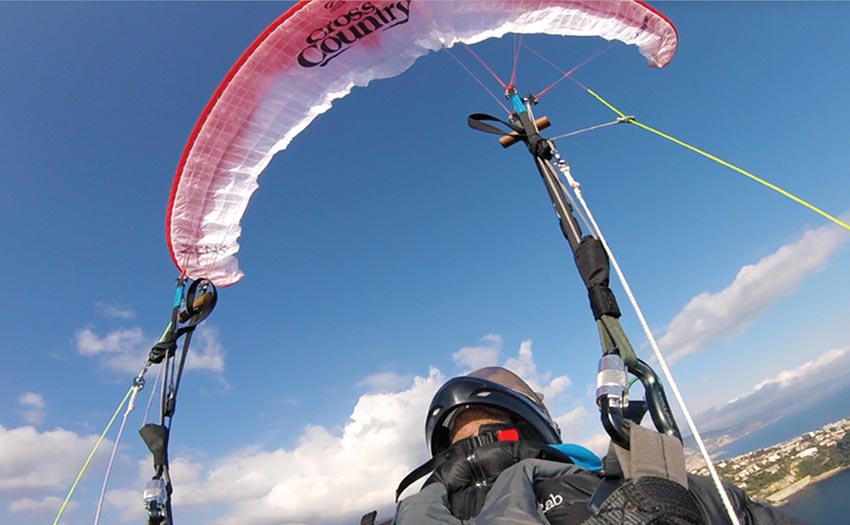
“The Zeno was actually OK – no dramas.”
On an early season SIV weekend above the Mediterranean. Photo: Hugh Miller
Stalls
Stalling a wing and getting it into a stable back-fly position is the recommended ‘reset’ button for most situations that get out of hand, so it’s very advisable that you get some practice at these, however scary they might seem. Over two days in Monaco I got some practise in on an EN-C glider first then moved on to the Zeno in the afternoon.
The Zeno was actually OK – no dramas. The tips stall much earlier than the centre, and care needs to be taken to ensure a symmetric recovery. We found that as you let up, it can ‘snatch’ back to flight on one side, needing you to re-stall that side. Russ Ogden says this is due to the brake fan arrangement, which has been optimised for normal handling rather than stalling cleanly. To ensure a more progressive entry, a tip is to hold your hands out to the side so you’re pulling the centre of the wing slightly more than the tips.
Compared with the EN-C, you just need to be more on-it to check any rotating on the Zeno as it loves a good squirrel around if it gets a chance.
I had two slightly messy efforts, with 180 degrees of rotation, but the third felt pretty nice. The glider drops back and starts to go into a V shape, and you let up immediately to rebuild the span, before immediately back down to around 60-70% of the initial brake travel to settle the wing back into tailslide. As it enters, if the brakes aren’t completely symmetric – level with each other – it will start to spin, so care needs to be taken. I’m used to getting cravats on recovery from stall, probably due to my poor technique, but on all three, I didn’t cop a single line-over on the Zeno, which was a bonus.
Harness
I’d recommend flying the Zeno with a seatboard harness. It’ll help damp out the ride, and settle the wing down in turbulence. With the Forza, in punchy cores I sometimes felt like I was being jerked up on one side, unloading the wing unnecessarily, and starting a sideways oscillation. With the Exoceat, this just wasn’t an issue. It was like flying with added suspension, with the harness absorbing the bumps and movements leaving me with a bit more thinking space.
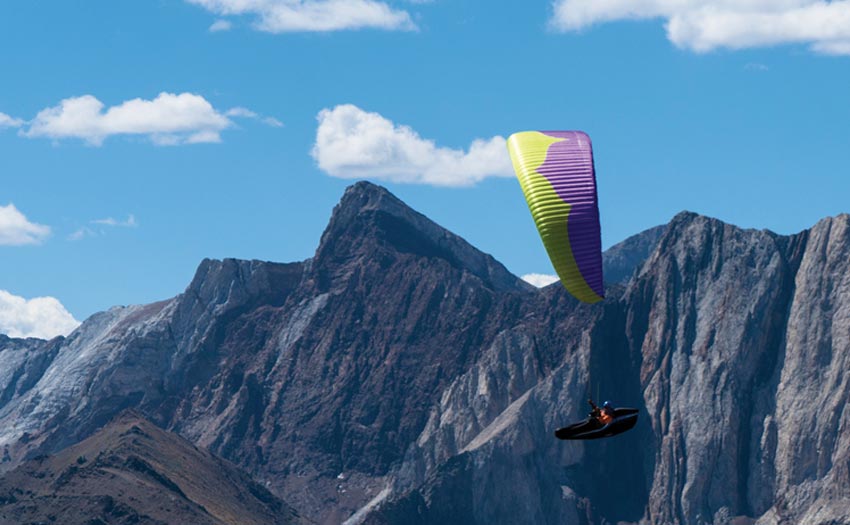
“I’d recommend flying the Zeno with a seatboard harness. It’ll help damp out the ride, and settle the wing down in turbulence. With the Exoceat, it was like flying with added suspension.”
Dave Turner in the Sierra Nevada, California. Photo: Cody Tuttle
In conclusion
I’m definitely a Zenophile, but I have reservations. As the saying goes, “You can’t cheat aspect ratio”, you can’t cheat the two-line nature of the Zeno either. As such, I’d always advise caution against progressing on to a wing like this too early. And while there’s definitely a ‘too early’, there isn’t really a ‘too late’, is there?
Fly a really comfortable wing and you might not get to goal first, but chances are you’ll be developing far more as a pilot than your friend whose nerves are shot from that leesider you both took on the way in.
I know my cautiousness is probably informed by seeing the fallout from too many pilots moving on to wings that are too hot for them too quickly. The last great exodus from our sport was in 2011, when several pilots got over-confident and burnt by Open Class wings. Back then, the wings had got too far ahead of the pilots’ skills levels. Few World Cup competitors invested enough time in SIV training, and paid the consequence.
But perhaps things are different, now. Perhaps there’s been a culture shift where the new generations of pilots have put in the hours and training to develop the necessary skills to fly two-liners safely. And if you count yourself amongst them, well, we are lucky to live in an age where Zenos exist, frankly. It’s an exquisite, energetic wing, and best of all, it’s set to wipe the smirks off every CCC pilot on the planet. World Cup performance with acceptable behaviour is finally here.
****
MANUFACTURER’S SPECIFICATIONS
What Ozone say: “The Zeno represents the cutting edge of Ozone paraglider R&D”
Use: XC and competition
Pilot level: advanced pilots, experts
Flat area (m²): 21, 22.5, 24.1, 26.5
Recommended take-off weight: 75-90, 85-100, 95-110, 105-125
Weight (kg): 4.8, 5, 5.3, 5.8
Cells: 78
Flat aspect ratio: 6.9
Certification: D
To stay up to date and read our reviews first, subscribe to Cross Country


